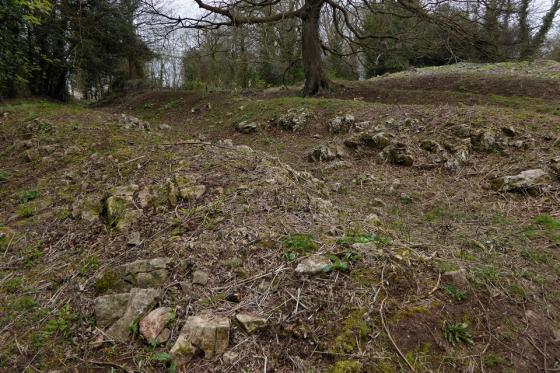There are two distinct groups of barrows on Brean Down, located on the eastern and western summits of the ridge. Pastscape descriptions:
Eastern group
Seven mounds are contained within the eastern field system on Brean Down. One of these is a round barrow, centred at ST 29325 58814. It is most likely to be the site that Skinner, writing in the early 19th century, found Roman pottery and human bones on the surface, and recorded that the primary deposit had been removed. The barrow lies just to the south of the Roman temple (ST 25 NE 6) and appears to overlie part of the field sytem. The NW side of the barrow has been damaged by ridge and furrow cultivation. A small hollow at the SE corner of the barrow represents the remains of a small building, visible on aerial photographs taken in 1948. Four small depressions on the W and E sides of the mound and to the S of the barrow probably mark the position of ApSimon’s trial trenches.
The mound centred at ST 29135 58925 may be a burial cairn. It is portrayed thus on a map of 1821. Silty clay has been dumped on the W end of the mound, obscuring its original form.
The remaining mounds are all small and are most likely to be clearance cairns or modified field banks. The mound centred at ST 2932 5881 is larger than the others, measuring 15m in diameter, has been interpreted as a round barrow or cairn which may be Bronze Age or Roman in date.
The other four mounds are centred at ST 2911 5893, ST 2913 5892, ST 2921 5889 and ST 2924 5887. They are predominantly sub-circular except for the largest mound and range in size, measuring between 3m in diameter and 7m by 10m. The largest of the mounds has been interpreted as a Bronze age burial mound. The other mounds may be clearance cairns which are possibly later in date.
Western group
Six mounds are contained within the western field system on Brean Down. Two of these are most likely to be small, Bronze Age burial cairns. The cairn at ST 28412 50920 is a low, circular, stony mound, close to a field bank. The cairn at ST 28519 59010 is a circular, turf-covered mound. Both of these cairns are shown on Colt Hoare’s map of 1821 as burial cairns.The large, flat-topped, sub-rectangular mound at ST 28487 59007 is surmounted by an OS trig. pillar. The hollow and small mound by the pillar suggest that the mound has been dug into. The field system may have incorporated an earlier cairn, or it may have been altered by the addition of a large burial cairn. The mound may have been augmented by field clearance. The present day appearance of the mound suggests that it may have been used as a beacon during the post medieval period.
The small rectangular mound on top of a field bank at ST 28647 58955 appears to be of recent construction. The mound at ST 28695 58942 is caused by the junction of two field banks, although it may have been augmented by field clearance. The sub-rectangular mound at ST 28733 58937 is part of a field bank, perhaps augmented by field clearance. A small hollow in its centre suggests that it has been dug into, and its northern end appears to have been modified by the removal of material.



























